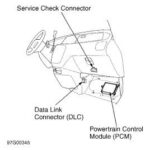For Jeep Cherokee enthusiasts, modifications and upgrades are part of the passion. If you’re considering an engine swap for your 1994 Cherokee, understanding the On-Board Diagnostics (OBD) system is crucial. Specifically, knowing whether your 1994 Jeep Cherokee is OBD1 or OBD2 is the first step in a successful engine upgrade, especially when considering newer engines like a 1999 TJ 4.0.
When undertaking an engine swap, such as replacing your original engine with a 1999 TJ 4.0 OBD2 engine, several key components need careful consideration. The electrical systems between OBD1 and OBD2 are significantly different, meaning a direct plug-and-play approach won’t work. To ensure compatibility and functionality, you will need to retain and swap specific parts between the engines.
From your original 1994 Jeep Cherokee OBD1 engine, it’s essential to keep components that directly interface with your existing wiring harness. These mainly include:
- Fuel Rail and Injectors: The 1994 Cherokee uses OBD1 style electrical connections and fuel line fittings, which are different from the OBD2 setup.
- Throttle Body with Sensors: To maintain compatibility with your Cherokee’s electronics, the original throttle body and its sensors should be retained.
- Throttle Cable Bracket: This ensures your existing throttle cables will properly connect to the swapped engine.
- Intake Manifold Air Temperature Sensor: While the OBD2 manifold will be used, the OBD1 sensor needs to be relocated, and wiring extended.
- Oil Sender and Oxygen Sensor: These sensors need to be carried over for correct readings with your 1994 Cherokee’s system.
- Water Temperature Sender: Similar to the air temperature sensor, this will need to be relocated to the side of the block using an adapter and wiring extension.
- Distributor Camshaft Position Sensor: Retain the OBD2 distributor but swap in the OBD1 Camshaft Position Sensor (CPS).
- Vacuum Line T-fittings: Some vacuum line adjustments will be necessary to integrate with the new engine.
- Fuel Line Bracket: This will require drilling a new hole to fit the OBD2 style manifold.
Mechanical components also require attention during this engine swap. Notably, the water pump from the 1994 OBD1 engine must be used on the OBD2 engine because the Cherokee’s fan setup differs from the TJ. Additionally, utilizing the OBD2 power steering pump is recommended as it bolts to the newer style manifold and includes an idler pulley for belt tension adjustments, along with the OBD2 belt arrangement.
Engine swaps can seem daunting, but with careful planning and attention to detail, integrating a newer 4.0 engine into your 1994 Jeep Cherokee OBD1 system is achievable. By focusing on the electrical and mechanical component swaps outlined, you can ensure a successful upgrade.
For further information and detailed guides on similar 4.0 engine swaps, you can refer to resources like:
